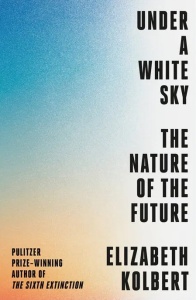 In Under a White Sky Elizabeth Kolbert, Pulitzer Prize-winning author of The Sixth Extinction, examines the future world we are engineering. Kolbert dispassionately reports on schemes to mitigate the multiple disasters we have created for ourselves — from climate change and ecological collapse to attempts to save isolated desert pupfish species from extinction. The title comes from geoengineering. If we were to seed the sky with particulates and chemicals to dim the sun and cool the earth, we would be living under white skies. Or the skies would be white — whether we’d be living is debatable. And that is the dilemma.
In Under a White Sky Elizabeth Kolbert, Pulitzer Prize-winning author of The Sixth Extinction, examines the future world we are engineering. Kolbert dispassionately reports on schemes to mitigate the multiple disasters we have created for ourselves — from climate change and ecological collapse to attempts to save isolated desert pupfish species from extinction. The title comes from geoengineering. If we were to seed the sky with particulates and chemicals to dim the sun and cool the earth, we would be living under white skies. Or the skies would be white — whether we’d be living is debatable. And that is the dilemma.
As Kolbert says, “This is a book about people trying to solve problems created by people trying to solve problems.” Without exception, the people she talks with are committed to their work, but their passion is hollowed by doubt. There is little rosy techno-optimism, quite a bit of grim techno-fatalism. Nobody believes these projects are the best. This is merely the best anyone has come up with in the context of wicked problems that likely have no best solutions.
The magnitude of suffering we have unleashed drives all these undertakings. We feel morally compelled to try to clean up our own messes, or at least reduce the damaging effects on innocents like coral and pupfish and future humans. So we are floundering around, striking at seemingly anything in the hopes of blindly hitting some desired target. These are projects that scare even those who are working on them. Geoengineering is manifestly terrifying, with enormous potential to blow up in our faces. But here is the conundrum: If it could reduce the pain and suffering we have inflicted upon the world, if it could help prevent total collapse of damaged ecosystems, aren’t we obligated to try it? As one scientist puts it “No one would undergo chemotherapy if there were any options.”
But to imagine that attempting these techno-solutions is less dangerous than not attempting them is to be confident that not only the technology will work according to plan (never a given) but also that it will be used and maintained according to plan (not that many plans have a maintenance or exit program). Assuming that, says Kolbert, “is a lot of imagining.” Scientists may originate these ideas and give advice, but implementation is a political decision and act. And we do not have a good record of making equitable political decisions with respect to the world around us or the world to follow us. Ergo climate change, among other things.
I sympathize with the urge to do something, even to use the questionable tools in our kit, but like Kolbert, I think it takes a lot of imagining to imagine that engineering problems have engineering solutions. There is the quote attributed to Einstein: “We cannot solve our problems with the same thinking we used when we created them.” He may never have actually said this, but he certainly was thinking in these terms when considering atomic weapons. He was speaking to the need for new ethical approaches and social structures — because clearly militarism can not protect us from militarism. Similarly, engineering can not protect us from engineering.
Kolbert gives us an excellent parable. I have to quote it at length because I think it is the entire problem encapsulated.
Project Iceworm was an exceptionally cold plan to win the Cold War. The US Army proposed boring hundreds of miles of tunnels into Greenland’s ice sheet. These would be outfitted with rail lines, and nuclear missiles would be shuttled along the tracks to keep the Soviets guessing. “Iceworm thus couples mobility with dispersion, concealment, and hardness,” a classified report boasted.
Pursuant to this plan, in the summer of 1959 the Army Corps of Engineers was dispatched to build a base. Situated at seventy-seven degrees north latitude, about a hundred and fifty miles east of Baffin Bay, Camp Century was by far the biggest thing ever erected on — or within — the ice sheet. Using what were essentially giant snowblowers, the Corps dug a large network of subsurface passages. Powering the enterprise was a portable nuclear reactor.
“Camp Century is a symbol of man’s unceasing struggle to conquer his environment,” declared a promotional film chronicling the herculean effort made by the Corps.
No sooner had construction been completed, than Camp Century’s troubles began. Ice, like water, flows. The Corps knew this and had built the dynamic into its calculations. But the Corps hadn’t adequately factored in the human factor — the way the heat from the reactor would speed up the process. Almost at once, the tunnels began to contract. To keep from being crushed, crews had to continually trim the ice with chainsaws. By 1964, the chamber housing the reactor had been so deformed, the unit had to be removed. In 1967, the whole base was abandoned.
This woeful tale could be interpreted as another Anthropocene allegory. Man sets out to “conquer his environment.” He congratulates himself for his resourcefulness and temerity, only to find the walls closing in. Drive out nature with a snowblower, yet she will always return — before you pack your tools away.
Mind you, this was the Army Corps of Engineers and the best technology the US military could buy. In other words, this “woeful tale” was brought to us by the brightest minds in engineering, using an unrivaled tool kit, probably still state of the art sixty years later. Yet the base did not last a decade; it does not even seem to have ever functioned as planned. We can snicker at the idea of putting a nuclear reactor in a glacier and not anticipating increased ice flow, but what fatal flaws — obvious only in hindsight — are lurking in geoengineering, for example?
We know that there are dangers. If we alter the atmosphere in this particular way, we may be shading the planet, but we aren’t reducing the greenhouse gas concentrations. If any number of predictable things interfere with the maintenance of this complex sun shade, the planet could see heating of 10°C or more in a very short time. This would all but wipe out human civilization and would cause enormous destruction in all life systems. And those are the known risks. We can’t do anything but fear the unknown unknowns, which are always legion in complex technology.
Of course, we can’t be expected to foresee how a complex system will evolve in time, while interacting with other complex systems. But there are indications that we aren’t even giving complex systems the consideration we know they deserve, preferring to wipe away all the variables and data that don’t fit in our models rather than accept that our models often don’t fit what we know — never mind what we don’t. We are a bit too fond of elegant solutions in a world that is rarely simple. We think a bit too highly of our capacity to make plans and often don’t sufficiently analyze those plans applied in the messy, unplanned, real world. We think that because we can think it, it will be.
This is a problem endemic to the engineering mindset, the view that clever tools will overcome all obstacles. For example, we talk of manned missions to Mars — which will require us to supply all air, food, fuel, medical supplies, building materials, specialized clothing and other shields, tools and equipment, probably water, and if it’s long-term all food-producing materials, including seed stocks, soil, and some form of protein-production. We must carry all this through space in a trip that takes over half a year. No popping off to the market if we run out of milk — or air. These are overwhelming obstacles. Moreover, we’ve not yet managed to build a self-contained habitat even on this planet. Yet we are confidant that we can engineer our way to living on a planet where exactly none of our biological needs can be met.
And again, we talk of vertical urban farming — indeed, I believe the current plans for future urban life are predicated on our ability to shorten food distribution chains through turning cities from consumers to producers. Yet I have not seen one vertical farm that produces grain. Moreover, soil-less farming does not produce plants that have complete nutrition — because soil is where the nutrition comes from and the interactions between soil microbes and plant roots are how those nutrients are taken up. No soil means no healthy plants means no food for us. And yet this is an essential part of our plan to make cities viable in a reduced emissions economy.
It is no coincidence that in all these problems — climate change mitigation, slowing ecological collapse, manned space flight, producing food sustainably — the solutions are focused on tools, but the problems are located in bio-geology. Which is notoriously averse to remaining within the confines of engineering. It is too complex for our tools. It is too complex for any tools. We can’t engineer a whole living organism. We do well when we can engineer a few sub-systems here and there.
So you see, I’m not quite sanguine about our ability to engineer solutions to the many-headed hydra of a problem that is biophysical breakdown on this planet. Humans barely understand how nature works in many fundamental ways, including our own biology. We can’t engineer what we can’t understand. We probably can’t engineer biological systems at all. No, I have more confidence in nature fixing itself than in humans fixing nature.
I think Kolbert would agree with me. That she wrote Under a White Sky without once passing judgement on engineering biology as a concept shows her amazing skill as a writer and a reporter. It is easy to write about what you agree with. It is very difficult to discuss disputable topics that challenge your beliefs with clarity and depth. But this is what is needed. We need to thoroughly analyze these plans before we set them in motion, and that analysis ought to come from outside science so as to avoid bias and emotional investment. Under a White Sky is an excellent contribution to that discussion.
©Elizabeth Anker 2021





